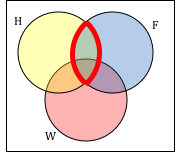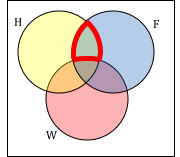Set Theory Basics
It is natural for us to classify items into groups, or sets, and consider how those sets overlap with each other. We can use these sets understand relationships between groups, and to analyze survey data.Introduction to Set Theory
An art collector might own a collection of paintings, while a music lover might keep a collection of CDs. Any collection of items can form a set.Set
A set is a collection of distinct objects, called elements of the set A set can be defined by describing the contents, or by listing the elements of the set, enclosed in curly brackets.Example
Some examples of sets defined by describing the contents:- The set of all even numbers
- The set of all books written about travel to Chile
Answer: Some examples of sets defined by listing the elements of the set:
- {1, 3, 9, 12}
- {red, orange, yellow, green, blue, indigo, purple}
Notation
Commonly, we will use a variable to represent a set, to make it easier to refer to that set later. The symbol ∈ means “is an element of”. A set that contains no elements, { }, is called the empty set and is notated ∅Example
Let A = {1, 2, 3, 4} To notate that 2 is element of the set, we’d write 2 ∈ AKey Takeaways
Union, Intersection, and Complement
Commonly, sets interact. For example, you and a new roommate decide to have a house party, and you both invite your circle of friends. At this party, two sets are being combined, though it might turn out that there are some friends that were in both sets.Union, Intersection, and Complement
The union of two sets contains all the elements contained in either set (or both sets). The union is notated A ⋃ B. More formally, x ∊ A ⋃ B if x ∈ A or x ∈ B (or both) The intersection of two sets contains only the elements that are in both sets. The intersection is notated A ⋂ B. More formally, x ∈ A ⋂ B if x ∈ A and x ∈ B. The complement of a set A contains everything that is not in the set A. The complement is notated A’, or Ac, or sometimes ~A. A universal set is a set that contains all the elements we are interested in. This would have to be defined by the context. A complement is relative to the universal set, so Ac contains all the elements in the universal set that are not in A.Example
- If we were discussing searching for books, the universal set might be all the books in the library.
- If we were grouping your Facebook friends, the universal set would be all your Facebook friends.
- If you were working with sets of numbers, the universal set might be all whole numbers, all integers, or all real numbers
Example
Suppose the universal set is U = all whole numbers from 1 to 9. If A = {1, 2, 4}, then Ac = {3, 5, 6, 7, 8, 9}.Try It Now
Example
Suppose H = {cat, dog, rabbit, mouse}, F = {dog, cow, duck, pig, rabbit}, and W = {duck, rabbit, deer, frog, mouse}- Find (H ⋂ F) ⋃ W
- Find H ⋂ (F ⋃ W)
- Find (H ⋂ F)c ⋂ W
Answer:
- We start with the intersection: H ⋂ F = {dog, rabbit}. Now we union that result with W: (H ⋂ F) ⋃ W = {dog, duck, rabbit, deer, frog, mouse}
- We start with the union: F ⋃ W = {dog, cow, rabbit, duck, pig, deer, frog, mouse}. Now we intersect that result with H: H ⋂ (F ⋃ W) = {dog, rabbit, mouse}
- We start with the intersection: H ⋂ F = {dog, rabbit}. Now we want to find the elements of W that are not in H ⋂ F. (H ⋂ F)c ⋂ W = {duck, deer, frog, mouse}
Venn Diagrams
To visualize the interaction of sets, John Venn in 1880 thought to use overlapping circles, building on a similar idea used by Leonhard Euler in the 18th century. These illustrations now called Venn Diagrams.Venn Diagram
A Venn diagram represents each set by a circle, usually drawn inside of a containing box representing the universal set. Overlapping areas indicate elements common to both sets. Basic Venn diagrams can illustrate the interaction of two or three sets.Example
Create Venn diagrams to illustrate A ⋃ B, A ⋂ B, and Ac ⋂ B A ⋃ B contains all elements in either set.Answer:
 A ⋂ B contains only those elements in both sets – in the overlap of the circles.
A ⋂ B contains only those elements in both sets – in the overlap of the circles.
 Ac will contain all elements not in the set A. Ac ⋂ B will contain the elements in set B that are not in set A.
Ac will contain all elements not in the set A. Ac ⋂ B will contain the elements in set B that are not in set A.

Example
Use a Venn diagram to illustrate (H ⋂ F)c ⋂ WAnswer:
We’ll start by identifying everything in the set H ⋂ F
 Now, (H ⋂ F)c ⋂ W will contain everything not in the set identified above that is also in set W.
Now, (H ⋂ F)c ⋂ W will contain everything not in the set identified above that is also in set W.

Example
Create an expression to represent the outlined part of the Venn diagram shown.
Answer: The elements in the outlined set are in sets H and F, but are not in set W. So we could represent this set as H ⋂ F ⋂ Wc
Try It Now
Create an expression to represent the outlined portion of the Venn diagram shown.
Exercises
What is the cardinality of P = the set of English names for the months of the year?Answer: The cardinality of this set is 12, since there are 12 months in the year. Sometimes we may be interested in the cardinality of the union or intersection of sets, but not know the actual elements of each set. This is common in surveying.
Exercises
A survey asks 200 people “What beverage do you drink in the morning”, and offers choices:- Tea only
- Coffee only
- Both coffee and tea
Answer:
This question can most easily be answered by creating a Venn diagram. We can see that we can find the people who drink tea by adding those who drink only tea to those who drink both: 60 people.
We can also see that those who drink neither are those not contained in the any of the three other groupings, so we can count those by subtracting from the cardinality of the universal set, 200.
200 – 20 – 80 – 40 = 60 people who drink neither.

try it now
Licenses & Attributions
CC licensed content, Original
- Mathematics for the Liberal Arts I. Provided by: Extended Learning Institute of Northern Virginia Community College Located at: https://online.nvcc.edu/. License: CC BY: Attribution.
- Learning Objectives and Introduction. Provided by: Lumen Learning License: CC BY: Attribution.
- Revision and Adaptation. Provided by: Lumen Learning License: CC BY: Attribution.
- Question ID 132343. Provided by: Lumen Learning License: CC BY: Attribution. License terms: IMathAS Community License CC-BY + GPL.
CC licensed content, Shared previously
- Math in Society. Authored by: David Lippman. Located at: http://www.opentextbookstore.com/mathinsociety/. License: CC BY-SA: Attribution-ShareAlike.
- Question ID 132343. Provided by: Lumen Learning License: CC BY: Attribution.
- Question ID 125855. Authored by: Bohart, Jenifer. License: CC BY: Attribution. License terms: IMathAS Community License CC-BY + GPL.
- Sets: drawing a Venn diagram. Authored by: David Lippman. License: CC BY: Attribution.
- Sets: drawing a Venn diagram. Authored by: David Lippman. License: CC BY: Attribution.
- Question ID 6699. Authored by: Morales, Lawrence. License: CC BY: Attribution. License terms: IMathAS Community License CC-BY + GPL.
- Sets: cardinality. Authored by: David Lippman. License: CC BY: Attribution.
- Question ID 125872, 109842, 125878. Authored by: Bohart,Jenifer, mb Meacham,William. License: CC BY: Attribution. License terms: IMathAS Community License CC-BY + GPL.
